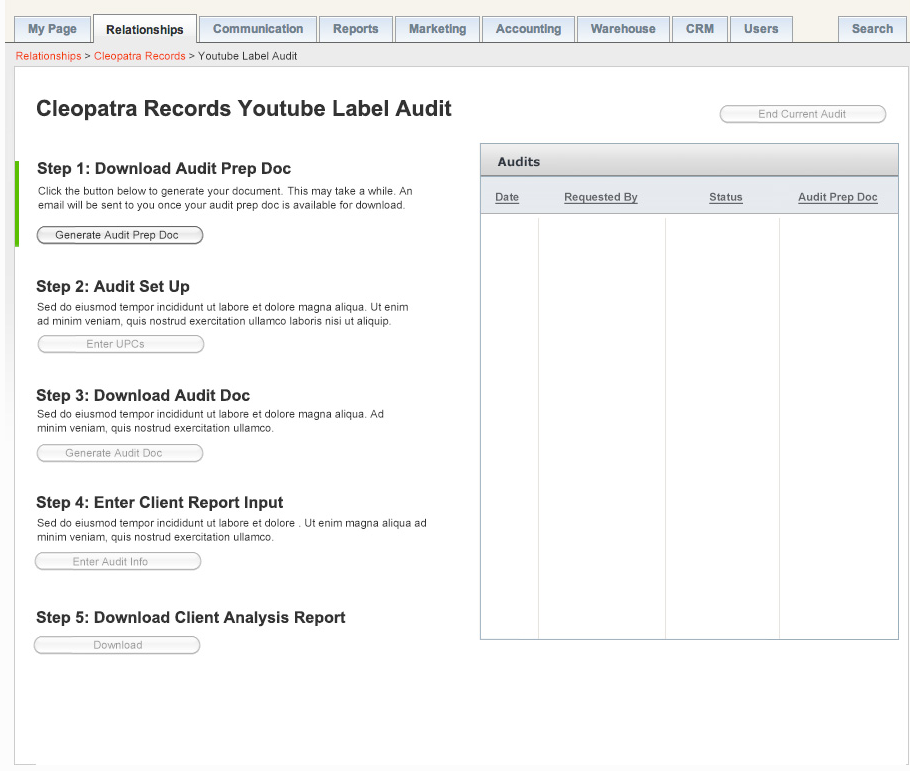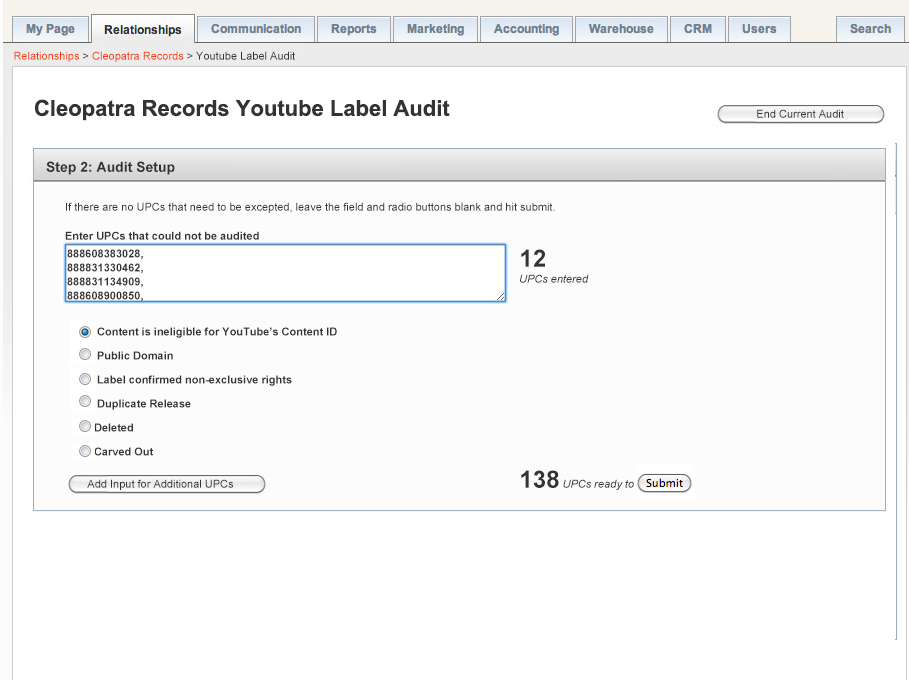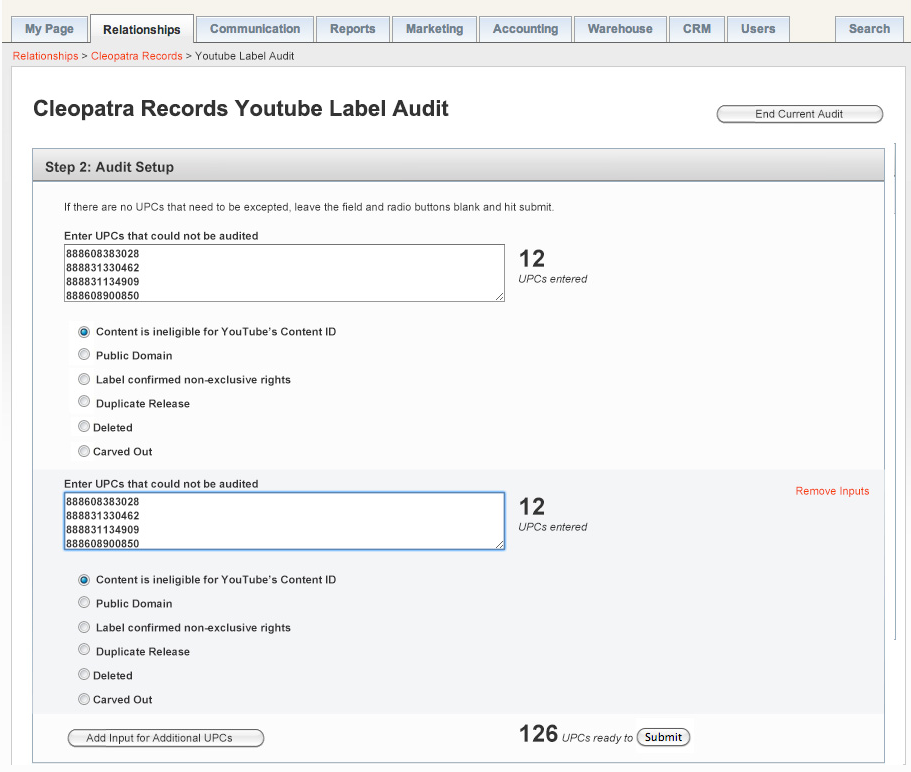BUSINESS CASE
Presently, the video services team performs “YouTube Label Audits” on an annual or semiannual basis for select, high-value/premium clients. The goal of these audits is to create a comprehensive analysis of the label’s assets in the Orchard system in order to:
- Ensure that each one of these is being monetized on YouTube in an optimal manner - to increase revenue (maximize revenue)
- Provide a service to our clients that is not offered by any other companies/competitors (competitive advantage)
The team manually performs many steps to go through our systems as well as the YouTube CMS to obtain all information necessary to this analysis. They then consult an exhaustive checklist for each asset to determine whether or not it is successfully monetizing on YouTube. If an issue is discovered, the specifics are logged in an Excel spreadsheet and corrective measures are undertaken to rectify the situation. After this has been performed for all of a label’s assets, a full report is prepared and delivered to the client explaining what happened and what benefit was provided to them.
This is a heavily manually process that requires many people to perform many repetitive tasks over a long period of time. Our eventual aim is to have this process automated end-to-end, but we have launched this functionality in discrete phases so that the automated steps can be incorporated into the existing business process as soon as they become available. This allow tangible process improvements to be realized long before the final completion stage.
VALUE PROPOSITION
Provides basic and premium partners with accessibility to key performance metrics of their partner channels across their network on YouTube.
ANALYSIS
Before the team can even begin analyzing a label’s assets on YouTube, they currently have to undergo a tortuous multi-step process to extract and transform all necessary information from our systems. The end goal of this process is to automate the generation of the audit doc, which is an Excel spreadsheet listing the tracks owned by a particular vendor and the corresponding asset data in YouTube for those tracks.
PROJECT GOALS
- Provide automated release and track-level reports in order to improve existing quality assurance procedures pertaining to audio content within YouTube’s CMS.
- Accurately ensure successful ingestion of selected content, and confirm that all corresponding assets are monetizing to full potential.
- Improve internal team efficiency by replacing a time consuming, manual auditing process, allowing team to expand audit services to a wider range of clients per year.
CURRENT CORE FEATURES
“YouTube Audit” button, located on label page in OA, allows team members to download a list of all audio UPCs. Tool automatically identifies carveouts/deletions, delivery dates and delivery feed, which eliminates the need to pull multiple reports prior to Release Check.
FUTURE CORE FEATURES
- Release Check process will be automated.
- Audit doc will be automatically generated based on results of Release Check.
- Automated audit will confirm each track is monetizing to full potential. Audit will also highlight key action items for team members to address and/or correct.
- Automatically identify problematic duplicate ISRCs (eliminating time-consuming Excel workaround).
- Analysis will be automatically generated to highlight actions that team members have taken, and will be available via client dashboard.
PROJECT PHASES
Phase 1.1 - Audit Prep Report Generation
Give users a quick way to access label specific data in OA. Once the relevant label audit prep information has been retrieved, the information is converted into an excel spreadsheet so the video services team can download and use for their audit.
Phase 1.2 - Release Check
The purpose of this phase is to confirm that the release is in CMS as expected.
Phase 1.3 - Duplicate Release Check
The team is currently working to manually identify duplicate releases. These are cases where the same release has two different UPCs. The cause of this generally being that for a given release, there were different release dates and so different UPCs were given to support this. Generally both releases are not being sent because it may override the existing UPC. The purpose of the Duplicate Release Check process is to:
- Determine if the release needs to sent
- Determine if the release already exists under a duplicate UPC
Phase 2 - Delivery Review
Reviewing the assets which are not in CMS and trying to determine whether they are not in CMS by error or on intention.
Phase 3 - Audit
Provides the auditor with actual audit prep doc to then perform the audit itself. This phase is composed primarily of flagging actionable steps for the auditor.
PROJECT IMPACT
Project Screens






